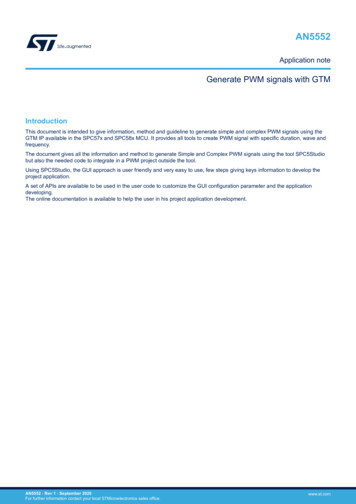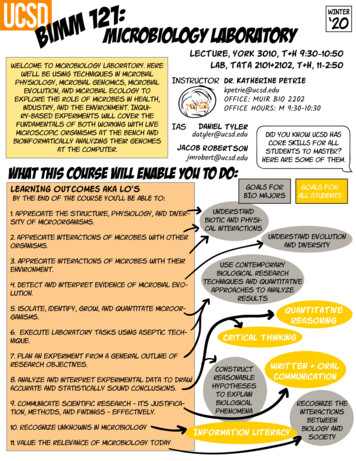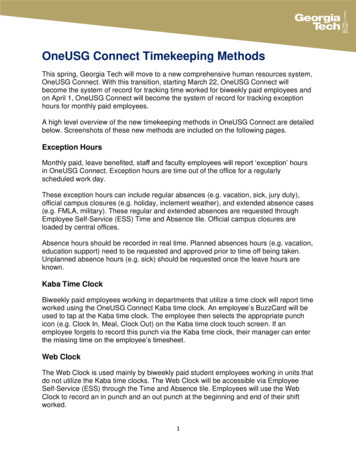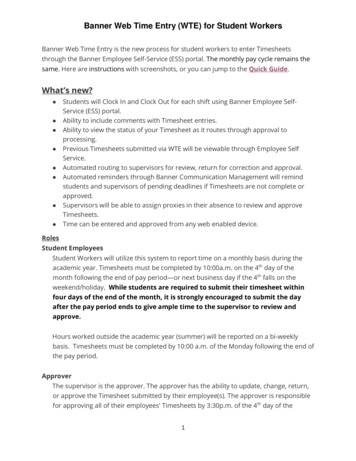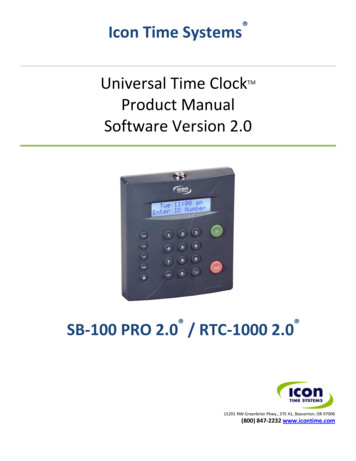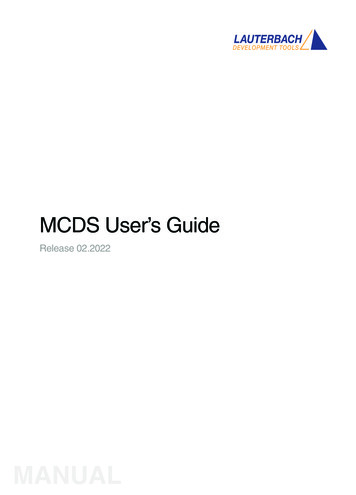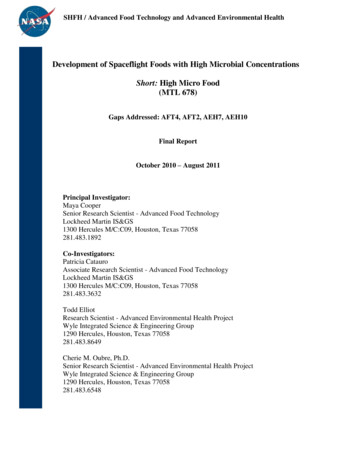
Transcription
RESEARCH ARTICLEelife.elifesciences.orgA microbial clock provides an accurateestimate of the postmortem interval in amouse model systemJessica L Metcalf1*, Laura Wegener Parfrey1†, Antonio Gonzalez1, Christian L Lauber2,Dan Knights3,4, Gail Ackermann1, Gregory C Humphrey1, Matthew J Gebert1,Will Van Treuren1, Donna Berg-Lyons1, Kyle Keepers1, Yan Guo5, James Bullard6,Noah Fierer2,7, David O Carter8, Rob Knight1,9,10,11*Biofrontiers Institute, University of Colorado at Boulder, Boulder, United States;Cooperative Institute for Research in Environmental Sciences, University ofColorado at Boulder, Boulder, United States; 3Department of Computer Science andEngineering, University of Minnesota, Minneapolis, United States; 4BioTechnologyInstitute, University of Minnesota, Saint Paul, United States; 5Field Application Support,Pacific Biosciences, Menlo Park, United States; 6Biostatistics, Pacific Biosciences, MenloPark, United States; 7Department of Ecology and Evolutionary Biology, University ofColorado at Boulder, Boulder, United States; 8Laboratory of Forensic Taphonomy,Division of Natural Sciences and Mathematics, Chaminade University of Honolulu,Honolulu, United States; 9Howard Hughes Medical Institute, University of Coloradoat Boulder, Boulder, United States; 10Department of Computer Science, University ofColorado at Boulder, Boulder, United States; 11Department of Chemistry andBiochemistry, University of Colorado at Boulder, Boulder, United States12*For correspondence: rob.knight@colorado.edu (RK);jessicalmetcalf@gmail.com (JLM)Present address: Departmentsof Botany and Zoology,University of British Columbia,Vancouver, Canada†Competing interests: See page 16Funding: See page 16Abstract Establishing the time since death is critical in every death investigation, yet existingtechniques are susceptible to a range of errors and biases. For example, forensic entomology iswidely used to assess the postmortem interval (PMI), but errors can range from days to months.Microbes may provide a novel method for estimating PMI that avoids many of these limitations.Here we show that postmortem microbial community changes are dramatic, measurable, andrepeatable in a mouse model system, allowing PMI to be estimated within approximately 3 daysover 48 days. Our results provide a detailed understanding of bacterial and microbial eukaryoticecology within a decomposing corpse system and suggest that microbial community data can bedeveloped into a forensic tool for estimating PMI.Received: 19 June 2013Accepted: 20 September 2013Published: 15 October 2013DOI: 10.7554/eLife.01104.001Reviewing editor: RobertoKolter, Harvard Medical School,United StatesIntroductionCopyright Metcalf et al. Thisarticle is distributed under theterms of the Creative CommonsAttribution License, whichpermits unrestricted use andredistribution provided that theoriginal author and source arecredited.Forensic science is concerned with identifying and interpreting physical evidence. Long-standingforms of physical evidence include fingerprints, bloodstains, hairs, fibers, soils, and DNA. However, anyobject can serve as physical evidence if it provides reliable insight into the activities associatedwith a death scene or crime. Physical evidence is often of critical importance to a criminal investigationbecause testimonial evidence, the statements provided by victims, suspects, and witnesses, is frequentlyincomplete and inaccurate (Saks and Koehler, 2005). To address these limitations of testimony, aninvestigator will compare the statements to the interpretation of physical evidence. For example, aninvestigator will require a suspect to provide an alibi to describe his or her whereabouts during thetime period of a crime and compare their statement to mobile phone activity.Metcalf et al. eLife 2013;2:e01104. DOI: 10.7554/eLife.011041 of 19
Research articleEcology Microbiology and infectious diseaseeLife digest Our bodies—especially our skin, our saliva, the lining of our mouth and ourgastrointestinal tract—are home to a diverse collection of bacteria and other microorganisms calledthe microbiome. While the roles played by many of these microorganisms have yet to be identified,it is known that they contribute to the health and wellbeing of their host by metabolizingindigestible compounds, producing essential vitamins, and preventing the growth of harmfulbacteria. They are important for nutrient and carbon cycling in the environment.The advent of advanced sequencing techniques has made it feasible to study the composition ofthis microbial community, and to monitor how it changes over time or how it responds to eventssuch as antibiotic treatment. Sequencing studies have been used to highlight the significantdifferences between microbial communities found in different parts of the body, and to follow theevolution of the gut microbiome from birth. Most of these studies have focused on live animals,so little is known about what happens to the microbiome after its host dies. In particular, it is notknown if the changes that occur after death are similar for all individuals. Moreover, the decomposinganimal supplies nutrients and carbon to the surrounding ecosystem, but its influence on themicrobial community of its immediate environment is not well understood.Now Metcalf et al. have used high-throughput sequencing to study the bacteria and othermicroorganisms (such as nematodes and fungi) in dead and decomposing mice, and also in the soilbeneath them, over the course of 48 days. The changes were significant and also consistent acrossthe corpses, with the microbial communities in the corpses influencing those in the soil, and viceversa. Metcalf et al. also showed that these measurements could be used to estimate thepostmortem interval (the time since death) to within approximately 3 days, which suggests that thework could have applications in forensic science.DOI: 10.7554/eLife.01104.002One of the most difficult forms of physical evidence to establish is the amount of time that haslapsed since death, the postmortem interval (PMI). Establishing the PMI is critical to every death investigation because it facilitates the identification of victims and suspects, the acceptance or rejection ofsuspect alibis, the distribution of death certificates, and the allocation of assets outlined in wills.However, PMI is difficult to establish because we have a relatively poor understanding of corpsedecomposition. To improve the ability to estimate PMI, forensic science has incorporated an ecologicalperspective. When an animal dies it becomes a large nutrient resource that can support a complex andphylogenetically diverse community of organisms (Mondor et al., 2012). As this decomposer communityrecycles nutrients, the corpse progresses through several forensically recognized stages of decomposition,including Fresh (before decomposition begins), Active Decay, which includes Bloating and Rupture,and Advanced Decay (Carter et al., 2007; Parkinson et al., 2009). Biotic signatures associated withthese stages of decomposition, such as the development rate of blow fly larvae (Amendt et al., 2007),succession of insects (Horenstein et al., 2010), and changes in the biochemistry of corpse-associated‘gravesoil’ (Tullis and Goff, 1987; Vass et al., 1992; Benninger et al., 2008; Carter et al., 2008;Horenstein et al., 2010), can be used to estimate PMI. However, no method is successful in everyscenario (Tibbett and Carter, 2008). For example, limitations of forensic entomology include uncertainty in the interval between death and egg deposition (Tomberlin et al., 2011), lack of insects duringparticular weather events or seasons (Archer and Elgar, 2003), and region-specific blowfly larvalgrowth curves and insect communities (Gallagher et al., 2010). Using microbial community change totrack the progression of decomposition may circumvent many of these limitations because microbesare ubiquitous in the environment, located on humans before death, and can be reliably quantifiedusing high-throughput DNA sequencing.Microbes play an important role in decomposition (Vass, 2001; Hopkins, 2008; Mondor et al.,2012). For example, from the Fresh stage to the Bloat stage, enteric microbes likely contribute toputrefaction by digesting the corpse macromolecules, which in turn generates metabolic byproductsthat cause the corpse to bloat (Mondor et al., 2012). Evans proposed that a major shift in microbialcommunities occurs at the end of bloat when the body cavity ruptures (Evans, 1963), as this key eventlikely shifts the abdominal cavity from anaerobic to aerobic. Additionally at the Rupture stage, nutrientrich body fluids are released into the environment often increasing pH (Carter et al., 2010) likelyMetcalf et al. eLife 2013;2:e01104. DOI: 10.7554/eLife.011042 of 19
Research articleEcology Microbiology and infectious diseasealtering endogenous microbial communities. The microbiology of corpse decomposition can now beinvestigated in detail by utilizing sequencing advances that enable entire communities to be characterizedacross the timeline of decomposition. These data will not only allow us to understand the underlyingmicrobial ecology of corpse decomposition, but also the feasibility of using microbes as evidence. Wemust rigorously test whether microbial community change is sufficiently measurable and directionalduring decomposition to allow accurate estimates of past events such as the PMI. Recently, Pechalet al. (2013) demonstrated that skin and mouth bacterial communities followed a consistent trajectoryof change during decomposition of three swine corpses over 5 days. Here, we expand upon theseinitial promising results by characterizing microbial community change in three external sites and oneinvasively sampled internal site in 40 destructively sampled mouse corpses over 48 days. In addition tocharacterizing bacterial community change of skin samples, we provide the first high-throughputsequencing characterization of microbial communities in the abdominal cavity and corpse-associatedsoils. Furthermore, we present the first high-throughput sequencing characterization of microbialeukaryotic community change (e.g., fungi, nematodes, and amoeba) associated with skin sites, theabdominal cavity and corpse-associated soils.We conducted a laboratory experiment to characterize temporal changes in microbial communitiesassociated with mouse corpses as they decomposed on soil under controlled conditions for 48 days.We characterized bacteria, archaea, and microbial eukaryotes using a combination of culture-independent,high-throughput DNA sequencing approaches for each sample. To characterize the composition anddiversity of bacterial and archaeal communities, we extracted DNA and sequenced partial 16S ribosomalRNA (rRNA) genes for each sample. To characterize the microbial eukaryotic community of each sample,we sequenced partial 18S rRNA genes. To accurately characterize these highly diverse microbial communities, we sequenced 100 base pairs of both 16S and 18S amplicons at a depth of millions of sequencesusing the Illumina HiSeq platform. In order to gain species and genus level taxonomic resolution of keytaxa, a much longer fragment of the rRNA gene (roughly 800 base pairs for 16S amplicons and 1200base pairs for 18S amplicons) was also sequenced at a level of thousands of sequences for a subset ofearly and late stage decomposition samples on the Pacific Biosciences RS platform. Together, thesedata allowed us to assess hypotheses long-held by the forensic community about the role of microbesin corpse decomposition, and rigorously test whether changes in microbial communities are predictableover the timeline of decomposition, which is crucial for assessing whether microbes can be used as a‘clock’ to estimate PMI.Results and discussionStudy design and data generationWe sampled the microbial communities from the mouse corpse abdominal cavity and skin (head andtorso), as well as from the associated gravesoil from five replicate corpses over eight time points thatspanned 48 days (Table 1, Supplementary file 1A). By using a mouse model, we were able to performa highly replicated experiment with destructive sampling that enabled us to sample both the surfaceand interior of each corpse at each sampling time point. Importantly, this approach facilitated accessto the abdominal cavity prior to natural corpse rupture, and thus our data addresses forensic hypothesesthat the abdominal microbes play a key role in corpse decomposition (Evans, 1963). This approachcontrasts with typical forensic studies of decomposition where one to three donated corpses of humanor swine (used as a human model) are used for experiments where only externally accessible body sitesare sampled (e.g., Pechal et al., 2013). A further advantage of using a mouse model system is that thelarge number of samples allowed us to assess to what extent the intra-individual variation of microbiotathat we know is present in living humans and other mammals (Costello et al., 2009) extends to microbialcommunity change during decomposition.Over the duration of our 48-day experiment, mice progressed through all major stages of decomposition (Figure 1). We assessed the progression of decomposition in two ways. First, we recorded avisual body score estimate for the head and torso according to Megyesi et al. (2005) at the timesamples were collected. Visual body score estimates suggested that day 0 and 3 primarily includedmice considered in the Fresh stage. Days 6, 9, and 13 included mouse corpses that were primarilyscored as Active Decay, including the Bloat stage on days 6–9. Finally, mice on days 20, 34, and 48were primarily categorized as Advanced Decay (Figure 1A). Second, after the conclusion of the experiment, we measured the pH of soil samples to estimate the timeframe during which the purging ofMetcalf et al. eLife 2013;2:e01104. DOI: 10.7554/eLife.011043 of 19
Research articleEcology Microbiology and infectious diseaseTable 1. Total number of samples collected for each site and abdominal, skin (head and body), soil(with and without corpses)Sample typeSamples collectedSamplessequenced(16S HiSeq)Samplessequenced(18S n of body5333310Skin of head4036296Soil with corpse5346608Soil no corpse12980Sum22316715226We show the number of successfully sequenced samples for each data type, including Illumina Hiseq and PacificBiosciences. For Illumina data, we only included samples used in statistical analyses, which required 2500sequences/sample. Details about each of the individual samples can be found in Supplementary file 1A.DOI: 10.7554/eLife.01104.003fluids or Rupture had likely occurred. It is well established that decomposition fluids are released froma body during decomposition (Carter et al., 2007). These fluids are a pulse of nutrients that increasethe pH of the surrounding soil. Measurements of soil pH indicated that Rupture (Active Decay) occurredbetween days 6 and 9 of the experiment (Figure 1B). Overall, we concluded that the mice were in theFresh stage on approximately days 0–3, the Active Decay stage on days 6–20 (with Bloat primarilyoccurring after day 3 until day 9 and Rupture occurring after day 6 and before day 9) and the AdvancedDecay on days 20–48. These stage classifications were used in subsequent analyses.In total, we collected 223 abdominal cavity, skin, corpse-associated soils samples (gravesoil), andno-corpse soil controls. After sequence quality filtering and removal of failed samples and sampleswith low numbers of sequences, the HiSeq Illumina sequence dataset included 167 samples and2,931,901 16S rRNA sequences that represented 4505 OTUs (Table 1, Supplementary file 1A). Aftersequence and sample filtering, the 18S dataset included 142 samples and 21,254,848 18S rRNAsequences that represented 421 OTUs (Table 1, Supplementary file 1A). Most samples with too fewsequences to be included in the final datasets (i.e., failures) were collected at early time points(e.g., days 0 and 3) when microbial biomass was likely low. This was especially true for eukaryotic skinsamples and abdominal cavity swab or liquid samples (although fecal and cecum day 0 samples workedwell as expected for these rich microbial habitats). The 16S and 18S Illumina HiSeq datasets were usedfor downstream statistical analyses (e.g., Mantel tests, PERMANOVA tests, and PMI estimates). Finally,for better taxonomic resolution via longer sequence reads, we also sequenced 26 samples usingPacific Biosciences sequencing platform resulting in a total of 16,250 sequences for 18S and 16S.These data were used separately from the Illumina data to identify highly abundant taxa presentduring early and late stage decomposition at the genus and species levels (e.g., the nematode speciesOscheius tipulae).The ecology of bacterial community change during decompositionIt has long been assumed that endogenous gut-associated bacteria dominate cadaver decompositionprior to rupture, following which non-enteric and aerobic (soil-borne, dermal) microbes bloom anddominate the community (Evans, 1963). Rupture is a crucial stage during decomposition, in whichbloating due to putrefaction breaks open the abdominal cavity, and is expected to result in shifts ofthe microbial community because the cavity becomes aerobic. Early culture-based investigationsconducted without soil lent support to this assumption by showing that many bacteria exploiting acarcass are members of the gut microbiota (Ingram and Dainty, 1971; Corry, 1978). Our results alsolend support to these long-held hypotheses. During the Bloating Stage (approximately days 6–9),endogenous anaerobes and facultative anaerobes that are known to be common members of the gutcommunity such as Firmicutes in the families Lactobacillaceae (e.g., Lactobacillus) and Bacteroidetesin the family Bacteroidaceae (e.g., Bacteroides) (Supplementary file 1B) increase in the abdominalcavity. However, after rupture occurs ( 9 days after the start of the experiment), these taxa decreasedramatically, and exposure of the abdominal cavity to oxygen allows aerobes such as members of theMetcalf et al. eLife 2013;2:e01104. DOI: 10.7554/eLife.011044 of 19
Research articleEcology Microbiology and infectious diseaseFigure 1. We used two independent methods to assess stages of decomposition: (A) a visual body score estimateof decomposition following the Megyesi Key (Megyesi et al., 2005) and (B) the pH of soil to determine whenrupture had occurred. (A) visual key estimates for the head (orange circle): Fresh–no discoloration (1 point); ActiveDecay–Discoloration (2 points), Purging of decomposition fluids out of eyes, nose, or mouth (3 points), Bloating ofneck and/or face (4 points); Advanced Decay–Sagging of flesh (5 points), Sinking of flesh (6 points), Caving in offlesh (7 points), Mummification (8 points). The key for the torso (blue triangle) is the same as above except thatBloating of abdominal cavity (3 points) precedes Rupture and/or purging of fluids (4 points). Gray boxes aroundpoints indicate generally with which stage of decay each time point is associated–Fresh ( days 0, 3), Active Decay( days 6, 9, 13), and Advanced Decay ( days 20, 34, 48). (B) Average pH of soil over time with standard error. Adramatic increase in pH occurred between day 6 and day 9, which is when rupture of body fluids and subsequentleakage into the soil likely occurred.DOI: 10.7554/eLife.01104.004Rhizobiales (Alphaproteobacteria) in the families Phyllobacteriaceae, Hyphomicrobiaceae, andBrucellaceae (e.g. Pseudochrobactrum and Ochrobactrum) to dominate (Figure 2A,B, Supplementaryfile 1B). Additionally, facultative anaerobes in the Gammaproteobacteria family Enterobacteriaceaesuch as Serratia, Escherichia, Klebsiella, and Proteus (Supplementary file 1B), which are widely recognizedas opportunistic pathogens and are associated with sewage and animal matter (Leclerc et al., 2001),become abundant after rupture.When corpses rupture they release an ammonia-rich, high nutrient fluid that alters both the pH andnutrient content of the soil (Meyer et al., 2013). Accordingly we saw a predictable spike in gravesoilpH from 6.0 to 8.5 (Figure 1B) and declines in Acidobacteria (Figure 2A), the abundance of whichis known to be inversely related to soil pH (Lauber et al., 2009). Acidobacteria prefer oligotrophicconditions (Fierer et al., 2007) and grow much more slowly than most other taxa (Ward et al., 2009;Castro et al., 2010), thus the decline of Acidobacteria may be related to the huge pulse of nutrientsinto the soil rather than shifts in soil pH. In this study, Alphaproteobacteria abundance (mainly theMetcalf et al. eLife 2013;2:e01104. DOI: 10.7554/eLife.011045 of 19
Research articleEcology Microbiology and infectious diseaseFigure 2. Bacterial community composition changes significantly and consistently over the course of decomposition. (A) Relative abundance of phyla ofbacteria over time for all body sites. For the abdominal site, Day 0 includes cecum, fecal, and abdominal swab and liquid samples. For the soil site,control soils collected on days 0, 6, and 20 are shown on the left of the plot. (B) The three bacterial families that show the greatest change in abundanceover time are plotted for each site. (C) PCoA plot based on unweighted UniFrac distances displaying bacterial community change at all sites duringdecomposition. Results from Mantel tests (Rho and p values) show that bacterial community change correlated significantly with time. The point ofrupture is marked with a thick vertical black line on each plot.DOI: 10.7554/eLife.01104.005Rhizobiales) increased across the sampling period and became most abundant post-Rupture stage soilsamples (Table 2), suggesting this group prefers a relatively nutrient rich environment and is able tooutcompete the Acidobacteria (Marilley and Aragno, 1999; Klappenbach et al., 2000; Smit et al.,2001) for the corpse derived resources. Such shifts in taxa composition were typical in these AdvancedDecay associated soil communities (after 20 days), which were significantly different from the time-zerosoil communities as well as the no-corpse soil controls (Figure 2A, Table 3, PERMANOVA p value 0.007).No-corpse control soils, which were collected throughout the experiment, did not change significantlyMetcalf et al. eLife 2013;2:e01104. DOI: 10.7554/eLife.011046 of 19
Research articleEcology Microbiology and infectious diseaseTable 2. The five most changing bacterial taxa groups resolved to the family level for each site overthe timeline of the experiment based on HiSeq Illumina resultsRank adalesXanthomonadaceaeGroups that increase in abundance are listed in bold text and groups that decreased in abundance are shown innormal text.DOI: 10.7554/eLife.01104.006over time (Mantel Rho 0.05, p value 0.35), linking soil community change to the presence of a corpse.Though preliminary, our work suggests that it may be possible to identify gravesoil by an increase inthe abundance of copiotrophic taxa relative to oligotrophic taxa.Bacterial communities associated with the decomposing corpses became increasingly differentiated from starting communities over time in the abdominal cavity, gravesoil, and skin sites (Figure 2,Table 4, Mantel test Rho values 0.36–0.55, p 0.001 for all sites). Although they did not convergecompletely, similar taxa became abundant at each sample site in the later stages of decomposition(Supplementary file 1C—weighted UniFrac distances between sample sites during Advanced Decaywere significantly lower than between sites during the Fresh stage, two sample t test 0.000001 foreach of five comparisons). For example, in both soil and skin, several bacterial families within theBacteroidetes (Sphingobacteriaceae), Alphaproteobacteria (Brucellaceae, Phyllobacteriaceae, andHyphomicrobiaceae), and Betaproteobacteria (Alcaligenaceae) increase in abundance during theAdvanced Decay stage of decomposition (Figure 2A,B, Table 2). This trend is consistent with previousfindings that bacterial skin communities are often a reflection of the surrounding environment withTable 3. For each sample site and each marker type, PERMANOVA results of UniFrac distance (unweighted)for Fresh (day 0–3 days) vs Advanced Decay (days 20–48) decomposition microbial communitiesPERMANOVA pseudo Fp value (999 permutations)16S soil with corpse2.380.00716S ctrl soil vs Advanced Decay soil2.540.00116S abdominal6.310.00116S skin on head8.190.00116S skin on body5.810.00118S soil with corpse10.170.00118S ctrl soil vs Advanced Decay soil5.230.00118S abdominal5.340.00118S skin on head–18S skin on body5.96–0.001For soil sites, we also include comparisons of control soils vs Advanced Decay gravesoils. For the 18S skin of head,there were not sufficient samples for statistical analysis.DOI: 10.7554/eLife.01104.007Metcalf et al. eLife 2013;2:e01104. DOI: 10.7554/eLife.011047 of 19
Research articleEcology Microbiology and infectious diseaseTable 4. For each sample site and each markertype, Mantel test results using Spearman’s rankcorrelation coefficient to assess the correlationbetween microbial community UniFrac distance(unweighted) and timeSpearman RhoSpearmanp value16S soil0.5480.00116S ctrl soil0.0510.352which they are in contact (Costello et al., 2009;Song et al., 2013), and this convergence mayalso arise because the low biomass initially foundon the skin is easily overwhelmed by soil taxa.The ecology of microbialeukaryotic community changeduring decompositionThe community of microbial eukaryotes alsochanged significantly and consistently over the16S abdominal0.3640.001time course of decomposition at all sampled sitesexcept the skin of the torso (Figure 3A, Table 4).16S skin of head0.3680.001Beginning at approximately 20 days, the micro16S skin of body0.4370.001bial eukaryotic community at all sites became18S soil0.7720.001dominated by a nematode, O. tipulae, in the18S ctrl soil0.1270.154family Rhabditidae (Figure 3B, Tables 2 and 5).18S abdominal0.2090.029Microbial eukaryotic community composition in18S skin of head0.2790.004the no-corpse control soils did not change significantly over time (correlation with time: Mantel18S skin of body0.0790.143Rho 0.15, p 0.13), though diversity did decline inImportantly, control soil microbial communities did notthe controls (Figure 4). Control soils were significhange significantly over time.cantly different from soils associated with corpsesDOI: 10.7554/eLife.01104.008in Advanced Decay (PERMANOVA pseudo-F5.23, p value 0.001). Furthermore, the nematodeO. tipulae was not detected at a level of 1% in any control soil sample.O. tipulae, a bacterivorous representative of the family Rhabditidae, is considered a commonnematode species of terrestrial habitats such as soil, leaf litter, and compost all over the world(Baille et al., 2008). As a consequence of the nematode bloom, Shannon diversity (communityevenness) declines at all sample sites for eukaryotic communities (t test Fresh Stage vs AdvancedDecay stage decomposition: soil p 0.001, abdominal p 0.002, skin p 0.03). Phylogenetic distancediversity estimates were variable across sample sites with a significant decrease only detected insoil (Figure 4). The nematode bloom is decoupled from rupture, and it appears that this generalistconsumer of bacteria responds to the increase in bacterial biomass that is associated with decomposition (Benninger et al., 2008; Carter et al., 2008, 2010; Parkinson et al., 2009; Damann etal., 2012) and outcompetes other community members. One potential contributing factor to thenematode bloom may have been the fact that the mouse graves were relatively closed systemsthat would have prevented entry of organisms preying on nematodes. Future experiments withopen systems will be necessary to determine the impact of higher trophic levels on communitydynamics.A microbial clock provides an accurate estimate of PMIBecause consistent shifts in the presence and abundance of specific bacterial and eukaryotic taxaoccurred during known stages of decomposition, these data suggested that succession of bacterialand microbial eukaryotic communities may be used to estimate PMI. By regressing known postmorteminterval directly on the taxon relative abundances using a Random Forests model. Random Forests isa machine learning technique that creates random decision trees based on subsets of the features(e.g., taxa) in the data, then chooses the subsets of features that are best able to classify samples intopredefined groups using only part of the data. This technique has been useful in other microbial ecologystudies, providing high classifier accuracy (Knights et al., 2011). We discovered that the temporalchange in microbial communities of the skin of the head allowed us to estimate PMI within as little as3.30 / 2.52 days (mean absolute error / standard deviation) (Figure 5). Regressions performedfor the timeframe of 0–34 days resulted in the smallest mean absolute error (Supplementary file 1D),which suggests that microbes may be more highly informative for estimating PMI during the earlierstages of decomposition, at least for the sites we sampled. However,
work could have applications in forensic science. DOI: 10.7554/eLife.01104.002. Ecology Microbiology and infectious disease Metcalf et al. eLife 2013;2:e01104. DOI: 10.7554/eLife.01104 3 of 19 . over the timeline of decomposition, which is crucial for assessing whether microbes can be used as a 'clock' to estimate PMI.
